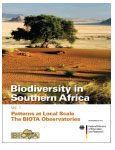Services on Demand
Article
Indicators
Related links
-
 Cited by Google
Cited by Google -
 Similars in Google
Similars in Google
Share
South African Journal of Science
On-line version ISSN 1996-7489
Print version ISSN 0038-2353
S. Afr. j. sci. vol.107 n.3-4 Pretoria Mar./Apr. 2011
http://dx.doi.org/10.4102/sajs.v107i3/4.646
BOOK REVIEW
From aardvark to z-values: A decade of biodiversity monitoring in Africa's arid and semi-arid southwest
Susanne Vetter
Botany Department, Rhodes University, Grahamstown, South Africa
Book Title: Biodiversity in southern Africa
Book Cover:

Editors: Norbert Jürgens; Ute Schmiedel; M. Timm Hoffman
ISBN: 978-3-933117-44-1 (Germany), 978-99916-57-30-1 (Namibia)
Publisher: Klaus Hess Publishers (Göttingen and Windhoek), 2010, R600.00*
In over 1400 pages, this epic three-volume book presents outputs and data from a decade-long research and monitoring project, BIOTA-Southern Africa. Most of the research was done in and around 37 standardised 1-km2 monitoring plots (the BIOTA observatories) spread over a transect from the woodland savannas of northern Namibia, through the thornbush savanna, Nama Karoo and desert biomes in Namibia, to Namaqualand and the western lowland fynbos in South Africa. As such, the title is somewhat misleading, as the geographical area covered encompasses Namibia and western South Africa. Also, while no doubt a major buzzword in the decade covered by the research, 'biodiversity' does little to capture the scope of the research presented, which covers climate, remote sensing, soils, fauna, flora and microorganisms, as well as ecological, legal and socio-economic aspects of land use and their implications for management.
Volume 1, 'Patterns at local scale - the BIOTA observatories', presents some background to the BIOTA project and the sampling methods employed at each of the observatories. This is followed by summaries for each observatory, including climate, topography, soils, biological soil crusts, lichens, vascular plants, some arthropod taxa, vertebrates, people and land use, and a summary of site-specific studies. The chapters in this volume are largely aimed at local land users and researchers working in the areas where the observatories are located. As such, some of the data could have been presented in a more user-friendly fashion: for example, the life-form composition of vascular plants would have been easier to interpret if terms like 'trees' and 'shrubs' had been used rather than abbreviated Raunkiaer categories. The presentation of the data, although standardised, varies between the different aspects measured and between observatories. Vascular plants, for example, were sampled annually at different scales and the species lists are extensive, detailed and consistent across all observatories. In contrast, the lists of vertebrates are very limited and at some locations comprise nothing more than a handful of bird species.
Volume 2, 'Patterns and processes at regional scale', is a collection of articles dealing with various aspects of the research, summarised for particular regions or across the entire transect. Articles range from reconstructions of past climate and vegetation change, through summaries of experimental and modelling work, to reflections on transdisciplinarity and stakeholder involvement. The scope, depth, originality and quality vary, with some articles reading a little like executive summaries listing achievements and outputs, while others present detailed and insightful syntheses of research findings. Clearly the (commendable) intention in publishing this book was to report the research findings as comprehensively as possible. The resultant variability was probably unavoidable, given that contributors ranged from coursework master's students to teams of senior researchers reporting on their core research over the last decade or more.
Volume 3, 'Implications for land use and management', presents syntheses of interdisciplinary research around land use impacts, each representing a different biome. The work in the woodland savannas of Namibia, for example, focuses on expanding cultivation but also touches on illegal logging (with an interesting video included in the electronic appendix). Research in the thornbush savannas centres around land degradation, in particular bush encroachment, while the chapter on fynbos focuses on the extent and consequences of fragmentation of lowland fynbos. These syntheses are generally interesting, and each ends with recommendations and thoughts on future research.
Overall, the book succeeds in giving a detailed overview of the research done, and is a valuable source of data and references. The objectives of the BIOTA project were to assess and monitor biodiversity, and to understand the drivers - especially climate and land use - that affect biodiversity patterns and processes in the study region. While valuable baseline data have been generated (which are available either in the electronic appendices included on CD or via the BIOTA website), the ultimate success of the project will be determined by the ability to continue monitoring over longer time scales. The data so far show quite clearly the difficulty in detecting long-term change in these arid and climatically variable ecosystems. The book provides relatively little analysis of temporal change, including the effects of climate change on biodiversity, despite the project's overriding focus on monitoring.
The three volumes are attractively presented, with many colour photographs giving readers a good impression of the study areas. The language editing, however, is quite poor and the quality of the figures variable. A subject index would have done much to make such a hefty book more user friendly, as would listing the authors of articles in the table of contents. As the book currently is available only from the publishers, it would be useful to have the table of contents listed on the publisher's website.
 Postal address:
Postal address:
PO Box 94
Grahamstown 6140, South Africa
email: s.vetter@ru.ac.za
© 2011. The Authors. Licensee: OpenJournals Publishing. This work is licensed under the Creative Commons Attribution License.
*Book price at time of review














